17 Aprile 2012
English
Light and Matter
The Exhibition
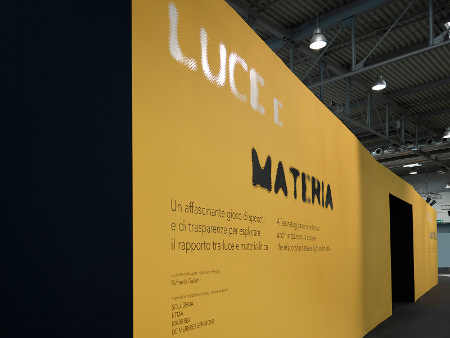
A fascinating game
of reflection and transparency
to explore the relationship
between light and marble
Working with marble and stone has always been conditioned by light. Sometimes the stonecutter chose a smooth surface, at other times a scuffed and grooved surface in order to obtain specific light and shadow effects.
I designed the “Light and Matter” exhibit to highlight optical characteristics of two particular, extremely different, even antithetical marbles: Merbes Esprimont’s Black marble from Belgium and Solubema’s light-hued Vigaria marble.
The former is quarried in Belgium from an ancient underground mine, the latter comes from Portugal from an open-air site. The arrangement winds through a sequence of rooms and the marble artifacts were designed and created so that two specific aspects of these materials would stand out: reflection and translucency.
The works were designed with the help of a computer and created with CNC machines and, where necessary, were polished by hand.
Reflection is a phenomenon that occurs when a ray of light hits a smooth surface and is projected back, thus restoring the previous image according to the established laws of physics. Black marble from Belgium is a compact, vitreous marble which, once it has been polished, has a mirror-like surface. The objects on display carved in Belgium Black explore the mirror theme, playing with fragmented reflections, distortions, anamorphosis, and quote a few historic examples. Light is repelled in a mirror; black, however, absorbs it. Light and these reflecting objects are permeated by this ambiguous duality, further enriched by the duality of reality and its double.
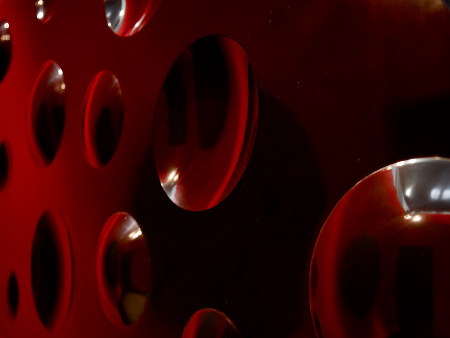
Translucency is the capacity of a body of mass to let the light through, and to diffuse it. Since Vigaria marble is particularly translucent, as light penetrates into it, it reveals a deep metamorphic pattem showing various pink, greyish, opalescent white veins, or even malachite green coloured streaks.
This property, which increases with increasing thinness, led to the creation of various luminous stone objects, such as slabs thinned down in order to create a figure, or geometric texture, or the effect of a shadow projected from the back or, lastly, illuminated lamps.
The working method, which consists of removing matter, did not follow traditional sculptural chiaroscuro canons of natural light from the sky.
The sculptor, in fact, knows very well that the black pupil of the eye in statues is not obtained with color but by digging a hole, thereby producing shadow. In our case, the removal of matter came about by following a different, or rather opposite principle, a negative in the photographic sense. In other words, the deeper the cavity the more luminous it is.
Let’s just think: this matter came to light from the underground after a very long time, during which it slowly grew and consolidated itself, until someone removed it from the ground to handle it and admire it.
Either black, as if soaked by the deep darkness of the ground, or crystalline white ready to emerge in the sunlight like a blooming flower, this material, once worked, thinly cut or shined, takes on different characters: it transforms itself. During this metamorphosis it reveals itself as surprising and fascinating.
Such extraordinary experience, originated in the attempt to expose the optical characteristics of the two materials, has uncovered new and stimulating aspects, of which I was unaware, as a demonstration of the enormous expressive potential of marble: an ancient material still waiting to be discovered.
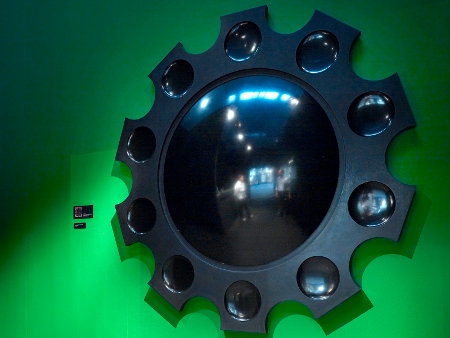
Entrance
In the entrance, leaning against a green wall, is a large round mirror made of Black marble from Belgium, a convex cap surrounded by a border of small hollowed (concave) mirrors. It obviously recalls the mirror portrait in the famous painting by Jan Van Eyck, The Arnolfini Portrait, where the artist paints a mirror, the reflected image of the sitters and himself at the same time. The small side concave mirrors produce a number of inverted images.
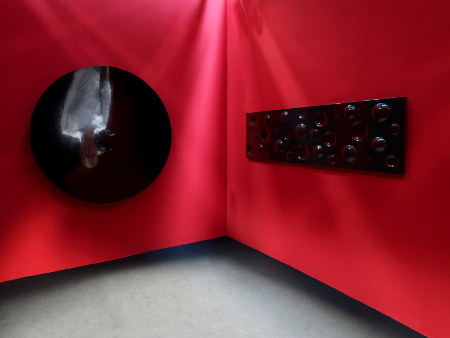
Hall of mirrors
In this red hall are collected eight mirrors made of Black marble from Belgium. The first is a large circular disc with a deformed surface, it is in fact a distorting mirror where the surface twists the image reflected, to the surprise and amusement of the spectator.
On another wall, the same theme is treated by four round mirrors, each one has a different kind of distorted surface which either squeezes the Image or turns it upside down.
On the third wall, two large distorting mirrors, oblong in shape, play with the visitor’s whole figure. On the fourth wall, a long rectangular mirror scattered with rounded bulging and hollowed caps reflects the surroundings, with a multiplying and up-turning effect.
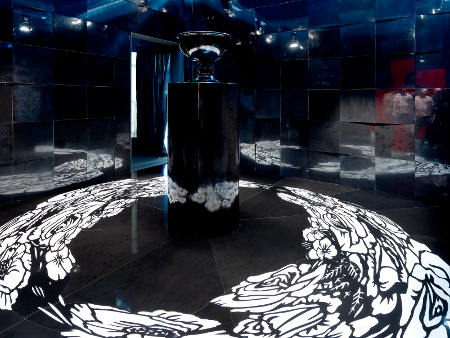
Hall of anamorphosis
A large black hall, completely lined in Black from Belgium; on the floor, visitors can see a twisted, indefinite figure inlaid in Vigaria marble. At the center of the hall, a majestic black marble cylinder is shining, topped by a classical vase, topped with a spherical cup. Inside the vase, a rich bunch of fresh roses.
As the visitor is reflected onto the shiny black floor and onto the central cylinder, his/her image is considerably distorted on the curved surface, where the figure on the floor clearly appears at the same time. It is a large anamorphic design which, according to precise optical rules, distorts itself to restore a correct vision on a curved surface. The same effect continues on the walls : the multiple images are broken down in a myriad of shiny black marble squares leaning in various directions, in a dizzlinng play of mirrors endlessly multiplied.
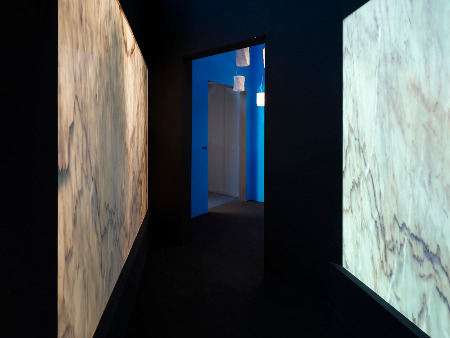
Luminous way
A passage designed in a slight perspective leads us to the next room.
On both walls there is a shiny Vigaria marble plate lit from behind, where moving figures can be perceived. On the right, one recognises a number of human figures, or rather their shadows, as if from the other side the plate lit by the setting sun revealed their presence. On the left wall, a shadow of trembling tree foliage lies over the golden marble matter of the Vigaria. The plates act as glass windows letting a golden light trough, while all the sedimentary veins of the marble are enhanced.
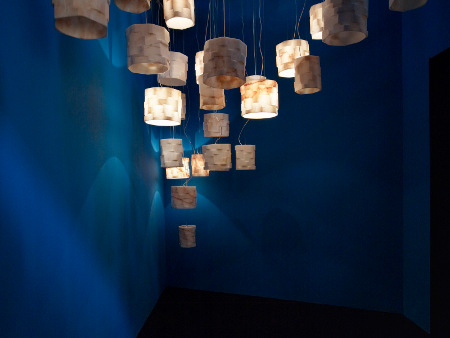
Hall of lamps
The sky blue room is dotted with lamps suspended at different heights; the light they cast is golden and it comes on and off with alternating pulsing rhythms. The lamps consist of solid Vigaria marble lampshades, regularly carved with grazes, which give out more light where the material is thinnner. The bright objects are the same in principle, but each one is unique because the patterns in t the marble are never the same.
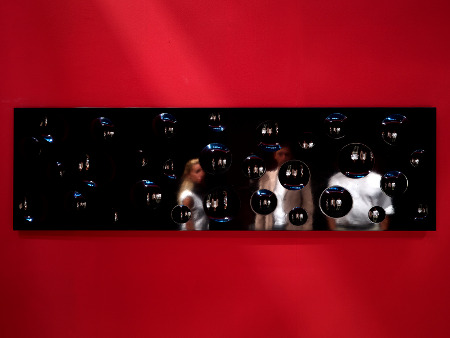
Hall of illuminated plates
This great hall features three large vertical four square meters slabs of considerable thickness that are hollowed out and illuminated.
The first slab shows on one side a carved bas-relief, with plenty of furrows and bulges; the surface has satin-finish and is off white color. Going around it you catch sight of the other side. From here, the plate is backlit displaying the internal amber light of the marble. A close second reading reveals the image of a rippling curtain, seemingly trapped inside the marble itself. After a closer third reading, yet another figure, a shadow of tree foliage appears on the curtain, projecting itself on the textile. Returning to the front of the plate, the amorphous bas-relief seen originally makes sense, each relief is a shadow, each hollow a light.
The second plate is located at the center of the room. It is carved on both sides, light hitting the milled surface intensely. Again in this case the bas-relief is difficult to read, flat patches following stronger reliefs. Light vanishes, then ignites on the other side, the plate is now lit from behind and a photographic picture appears as by magic. The head and face of a child, a fetal image created in matter, contained inside this primordial membrane resembling a vascularized cloth. Marble become body.
The third plate has a smooth and flat surface that is evenly lit. Light vanishes and bright points appear growing more and more intense. Others appear, it’s a meteor of square shaped lights, here and there, bigger, smaller, more intense or dimmer. Maybe the lights of a veiled city. On the back, the worked surface is scattered with hollowed squares of different size and depth.
Raffaello Galiotto
